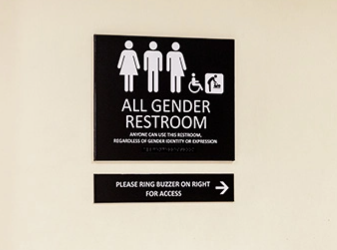The Americans with Disabilities Act (ADA) mandates specific guidelines for restroom signage to ensure accessibility for individuals with disabilities. These regulations cover various aspects, including the sign’s design, placement, and content. This blog post will delve into the intricacies of ADA restroom signs, providing essential information for business owners, facility managers, and anyone responsible for ensuring compliance.
Understanding the Importance of ADA Restroom Signs
ADA restroom signs are more than just markers; they are crucial tools for creating an inclusive environment. These signs facilitate independent navigation for people with visual impairments, allowing them to locate restroom facilities confidently. Moreover, proper signage enhances the overall user experience for everyone, promoting a sense of comfort and accessibility.
Key Components of ADA Restroom Signs
To meet ADA requirements, restroom signs must incorporate the following elements:
- Clear and Consistent Symbols: The signs should use universally recognized symbols for male, female, and unisex restrooms. These symbols must be clear and easily distinguishable.
- Tactile Text: Essential information, such as “Restroom” or “Men/Women,” should be included in raised letters or braille to accommodate individuals with visual impairments.
- Proper Placement: Restroom signs must be installed at a visible height, typically between 48 and 60 inches from the floor. The signs should be placed near the entrance to the restroom and in a location that does not obstruct pedestrian traffic.
- Contrast: The colors used for the sign and its background should provide sufficient contrast to ensure visibility for people with low vision.
- Size and Spacing: The letters and symbols on the sign must adhere to specific size and spacing requirements to be legible.
Types of ADA Restroom Signs
There are several types of ADA restroom signs, each serving a specific purpose:
- Unisex Restroom Signs: These signs indicate a restroom that can be used by individuals of any gender. They typically feature a stylized person icon or the word “Unisex.”
- Family Restroom Signs: These signs designate restrooms designed for families with young children. They may include symbols for both male and female and often feature a changing table icon.
- Accessible Restroom Signs: These signs mark restrooms that are specifically designed to accommodate individuals with disabilities. They include the international symbol of accessibility and may also indicate additional features, such as a wheelchair-accessible stall or a baby changing station.
- Restroom Occupancy Signs: These signs indicate whether a restroom is occupied or vacant. They often feature a red or green light or a digital display.
Additional Considerations for ADA Compliance
Beyond the basic requirements, there are additional factors to consider for ADA restroom sign compliance:
- Sign Material: The material used for the sign should be durable and resistant to damage.
- Lighting: Ensure adequate lighting around the restroom entrance to enhance sign visibility.
- Maintenance: Regularly inspect and maintain restroom signs to ensure they are in good condition and legible.
- Alternative Formats: Consider providing alternative formats of restroom information, such as audio announcements or visual cues, for individuals with specific needs.
The Impact of Non-Compliance
Failing to comply with ADA restroom sign regulations can have serious consequences. Businesses may face legal penalties, negative publicity, and damage to their reputation. More importantly, non-compliance creates barriers for individuals with disabilities, limiting their ability to access essential facilities.
By understanding and implementing ADA restroom sign guidelines, businesses and organizations can create inclusive environments that welcome and accommodate everyone.



